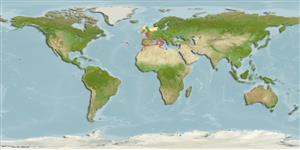Teleostei (teleosts) >
Beloniformes (Needle fishes) >
Exocoetidae (Flyingfishes)
Etymology: Cheilopogon: Greek, cheilos = lip + Greek, pogon = barbed, beard (Ref. 45335).
More on author: Rafinesque.
Environment: milieu / climate zone / depth range / distribution range
Ecology
Marine; pelagic-neritic; oceanodromous (Ref. 51243); depth range 0 - 50 m. Subtropical; 59°N - 30°N, 65°W - 16°E
Eastern Atlantic: southern Norway and Denmark (rare) to Gibraltar and western Mediterranean. Western Atlantic: around Bermuda (Ref. 26938). Eastern Indian Ocean: Western Australia (Ref. 49596) and Victoria, Australia (Ref. 33839). Also throughout subtropical waters of the Pacific Ocean (Ref. 33839).
Size / Weight / Age
Maturity: Lm ? range ? - ? cm
Max length : 40.0 cm TL male/unsexed; (Ref. 5377); common length : 15.0 cm TL male/unsexed; (Ref. 6077)
Pelagic, coastal species which can fly over long distances. It is thought that this behavior is a means to escape danger. This flying fish is not commercially exploited although it is very good to eat (Ref. 5377). Spawns during summer in Italian waters. Eggs with filaments over the entire surface (Ref. 6523).
Life cycle and mating behavior
Maturities | Reproduction | Spawnings | Egg(s) | Fecundities | Larvae
Bauchot, M.-L., 1987. Poissons osseux. p. 891-1421. In W. Fischer, M.L. Bauchot and M. Schneider (eds.) Fiches FAO d'identification pour les besoins de la pêche. (rev. 1). Méditerranée et mer Noire. Zone de pêche 37. Vol. II. Commission des Communautés Européennes and FAO, Rome. (Ref. 3397)
IUCN Red List Status (Ref. 130435)
Threat to humans
Harmless
Human uses
Fisheries: of potential interest
Tools
Special reports
Download XML
Internet sources
Estimates based on models
Preferred temperature (Ref.
123201): 11.8 - 21, mean 17.5 °C (based on 140 cells).
Phylogenetic diversity index (Ref.
82804): PD
50 = 0.5000 [Uniqueness, from 0.5 = low to 2.0 = high].
Bayesian length-weight: a=0.00646 (0.00292 - 0.01429), b=3.04 (2.84 - 3.24), in cm total length, based on LWR estimates for this (Sub)family-body shape (Ref.
93245).
Trophic level (Ref.
69278): 3.4 ±0.45 se; based on food items.
Resilience (Ref.
120179): High, minimum population doubling time less than 15 months (Preliminary K or Fecundity.).
Fishing Vulnerability (Ref.
59153): Low to moderate vulnerability (30 of 100).
Nutrients (Ref.
124155): Calcium = 208 [75, 435] mg/100g; Iron = 1.75 [0.86, 3.98] mg/100g; Protein = 17.7 [15.6, 19.6] %; Omega3 = 0.344 [0.159, 0.953] g/100g; Selenium = 25.9 [11.7, 54.0] μg/100g; VitaminA = 15.3 [4.6, 59.1] μg/100g; Zinc = 0.83 [0.57, 1.25] mg/100g (wet weight);
